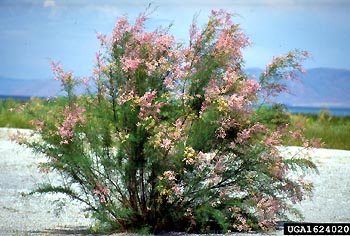Saltcedar

Common Name(s):
Saltcedar
Tamarisk
Scientific Name:
Tamarix ramosissima Ledeb.
Scientific Name Synonyms:
Tamarix chinensis Lour.
Symbol:
TARA
Description:
Life Span: Perennial
Origin: Introduced
Season: Deciduous
Growth Characteristics: Originally introduced as an ornamental in the 1800's, saltcedar is a long-lived (50-100 yrs), dense growing shrub or tree, growing 6 to 26 feet tall. The crown is narrow or rounded. Saltcedar has a deep taproot and extensive lateral rhizomes. Secondary root branching is profuse upon contact with water. Flowering occurs from March through September. It reproduces from seeds, as well as root sprouts.
Flowers/Inflorescence: Flowers are white to pink, each 1/16-inch long, and grow in long (1-2 inches), narrow, drooping cluster. Flowers are primarily insect pollinated. It generally does not begin to flower until its third year of growth.
Fruits/Seeds: A mature saltcedar can produce 600,000 seeds annually. Seeds are very small with a tuft of hair at one end, which aids in dissemination by wind and water.
Leaves: Scale-like, bluish-green leaves, growing up to 1/16 inch long. Dead leaves are often retained on the tree into the winter.
Stems: Branches are smooth, slender, flexible, and break off easily. The bark of saltcedar is smooth, becoming furrowed and ridged with age. The wood is soft and white.
Ecological Adaptions:
Saltcedar commonly occurs along floodplains, riverbanks, stream courses, salt flats, marshes, and irrigation ditches in arid regions of Utah at elevations from 4,200 to 7,000 feet. It often forms pure thickets that extend for miles.
Once established, saltcedar can tolerate both drought and flooding. By shedding its leaves and halting growth, it can withstand lengthy drought periods. It can also survive inundation by water for up to 3 months.
Saltcedars roots may penetrate the soil 30 feet or more. It's dense roots and rhizomes spread out and slow river flow, which increases deposition, and can cause rechanneling of streams and rivers.
Soils: Grows well on moist sandy, sandy loam, loamey, and clayey soil textures. It has a wide range of tolerance to saline and alkaline soils and water. Leaf drop increases the salinity of the surface soil causing the white color and the name saltcedar.
Associated Species: Coyote willow, Fremont cottonwood, greasewood.
Uses and Management:
Saltcedar changes the ecology and hydrology of riparian systems. It has one of the highest evapotranspiration rates of any riparian shrub, removing water from the soil and releasing it through the leaves. Water loss caused by saltcedar can range to 13 acre-feet per year. Sites invaded by saltcedar can become drier, and stream flows reduced. Because of this, saltcedar communities are generally less valuable to any life form than the native riparian plant communities it replaces. It does provide nesting for birds, and is an important pollen source for honeybees. It is also used by blacktailed jackrabbits as a major food source. It is relatively unpalatable to most classes of livestock and wildlife.
Saltcedar has been planted for erosion control and windbreaks because it is one of the few species capable of colonizing and stabilizing extremely saline soils.
When control is needed, saltcedar is difficult or impossible to kill by burning, drought, freezing, hypersalinity, prolonged submersion, or repeated cutting at ground level. However, saltcedar can be controlled using a combination of methods, usually involving herbicide application as one of the methods.
Medicinally, saltcedar species have been used to treat stomach troubles, diarrhea, rheumatism, rickets, and as astringents and antiseptics.

